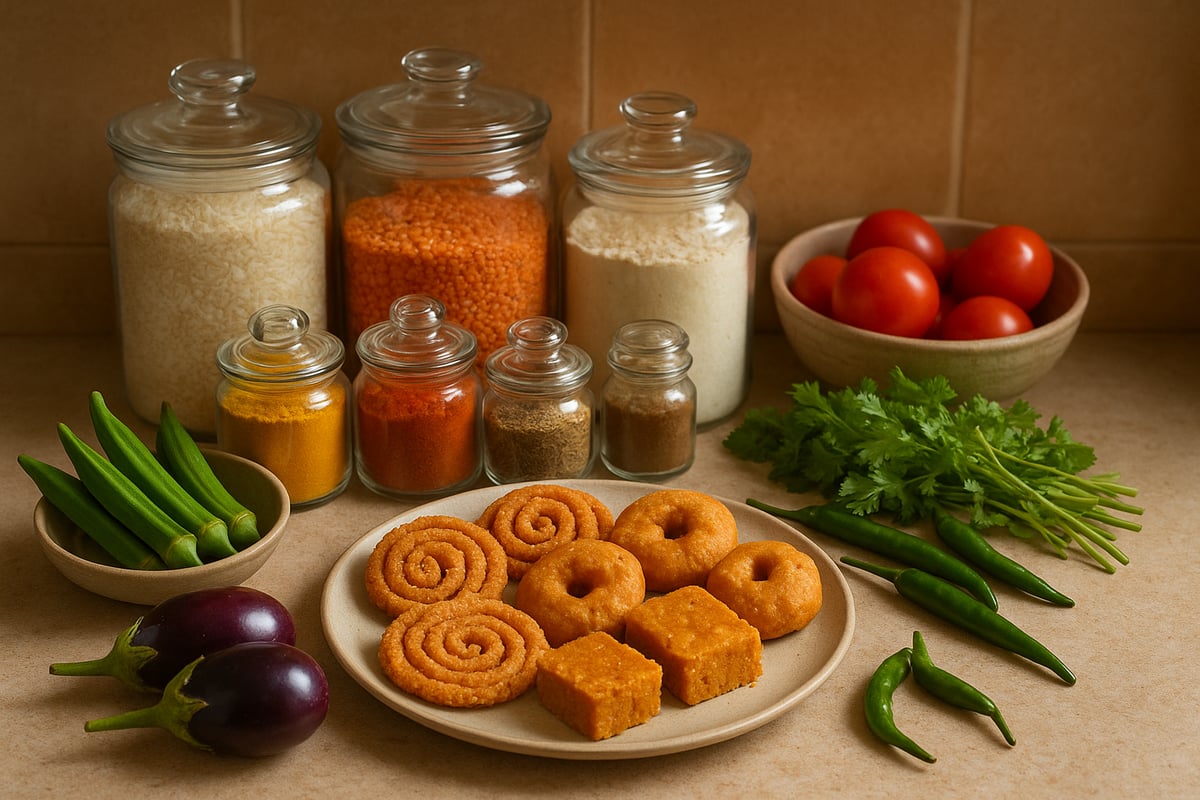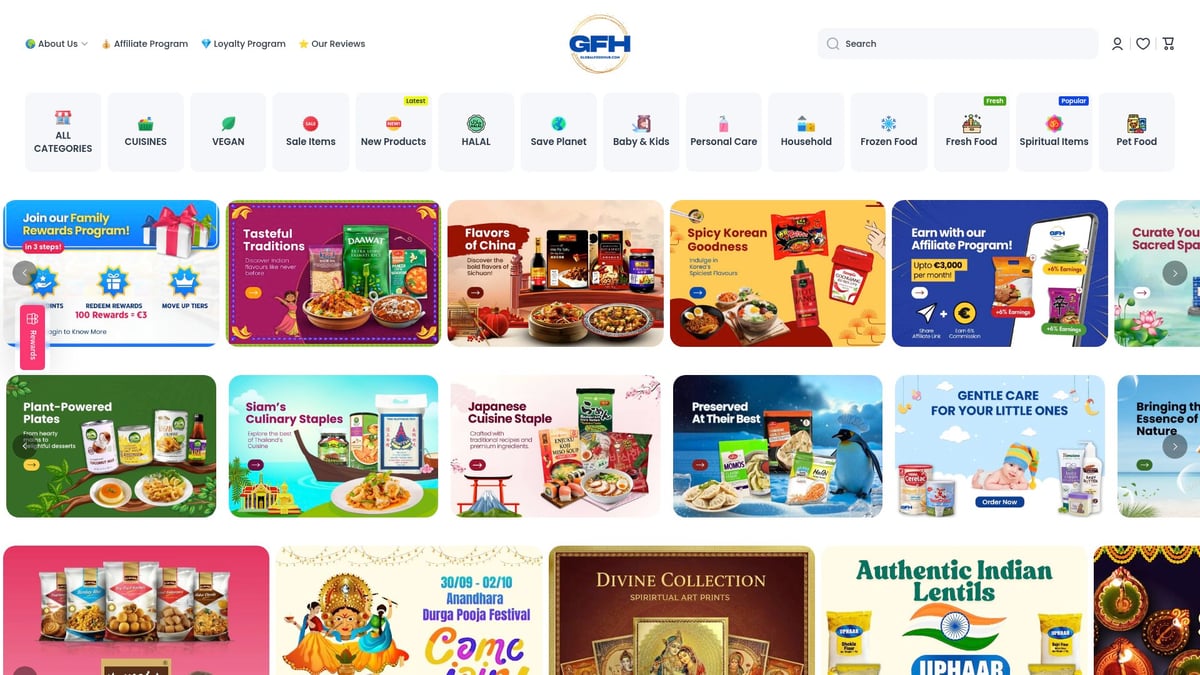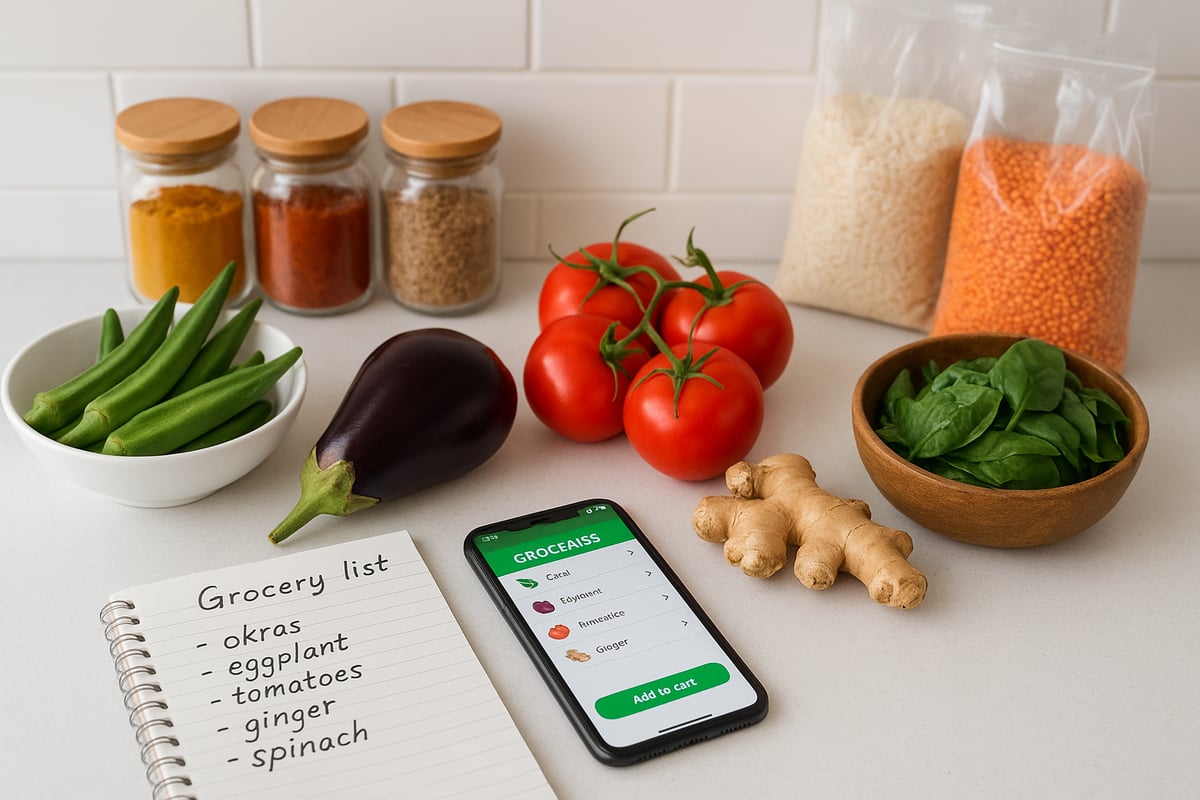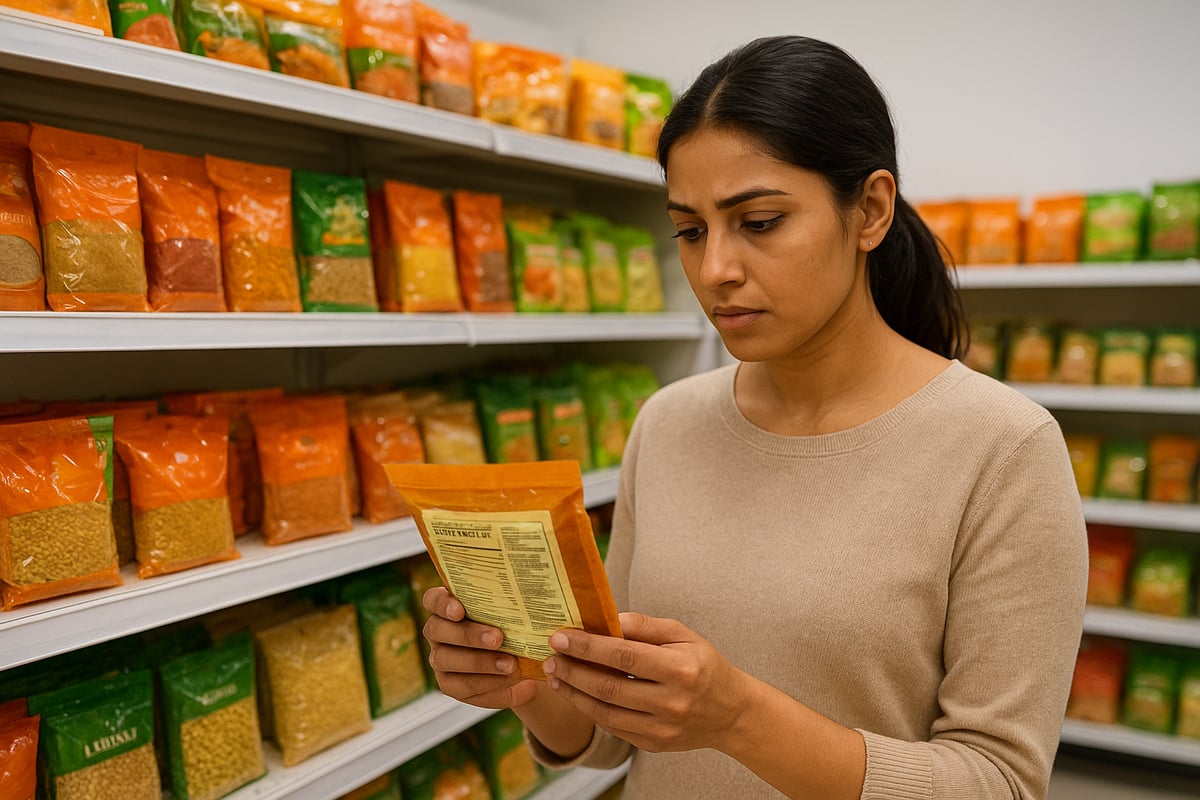Dreaming of cooking authentic Indian meals in 2025, but overwhelmed by endless grocery choices? You are not alone. Navigating the world of indian grocery shopping can feel like a maze, whether you are a beginner or a seasoned cook. This guide is designed to be your trusted companion, simplifying every step and making sure you never miss an essential ingredient. Discover the must-have staples, learn to shop smarter with the latest trends, and get practical tips for special diets and modern shopping channels. Let’s demystify indian grocery shopping together and make your kitchen ready for any recipe.
Understanding the Indian Grocery Essentials
Mastering indian grocery shopping means knowing your essentials. The Indian kitchen is built on a foundation of pantry staples, fresh produce, flavorful dairy, and region-specific ingredients. Whether you are a beginner or a seasoned cook, understanding these essentials helps you shop smarter and cook with confidence.

Defining Indian Pantry Staples
Every successful indian grocery shopping trip starts with pantry staples. Rice, lentils, and flours are the backbone of countless Indian dishes. Popular choices include basmati rice, toor dal, and besan (chickpea flour). Oils like mustard or sunflower, and ghee, provide authentic flavor and richness.
Spices and masalas are essential for regional diversity, offering depth and character to each meal. Convenience is also key, with canned tomatoes or dried beans saving time without sacrificing taste. For a comprehensive view of these basics, visit the Indian grocery staples collection for inspiration and sourcing options.
Fresh Produce and Herbs
Fresh produce is the heart of indian grocery shopping. Common vegetables such as okra, eggplant, and bitter gourd bring signature tastes and textures. Leafy greens like spinach, fenugreek, and coriander are must-haves for both nutrition and flavor.
Herbs and chilies add the finishing touch, delivering aroma and heat to every dish. Always prioritize freshness, as it makes a noticeable difference in Indian cooking.
Dairy, Snacks, and Sweets
Dairy products play a central role in indian grocery shopping. Paneer, yogurt, and ghee are used in everyday and festive meals. Snacks like samosas and namkeen offer quick bites, while ready-to-eat options bring convenience.
Sweets, or mithai, are closely linked to celebrations. Favorites like rasgulla and gulab jamun are enjoyed during festivals and family gatherings, making them essential additions to your shopping list.
Specialty Items for Dietary Needs
Modern indian grocery shopping caters to many dietary preferences. Gluten-free, vegan, and organic items have become widely available. Millet flours, non-dairy ghee, and plant-based snacks are increasingly popular, meeting the needs of health-conscious families.
Recent data shows growing interest in specialty diets among Indian households. This trend means more choices and better options for everyone at the grocery store.
Regional Variations in Essentials
India’s diverse regions shape grocery lists in unique ways. North Indian staples differ from those in the South, East, or West. For example, coconut is a staple in the South, while mustard oil is favored in the East, and jaggery is essential in the West.
| Region | Unique Essential | Common Use |
|---|---|---|
| North | Basmati rice | Biryanis, pulao |
| South | Coconut, curry leaves | Chutneys, curries |
| East | Mustard oil, panch phoron | Fish, vegetables |
| West | Jaggery, bajra flour | Sweets, rotis |
Recognizing these differences is crucial for authentic indian grocery shopping, ensuring your dishes reflect their regional origins.
Navigating Modern Indian Grocery Shopping Channels
Embarking on indian grocery shopping in 2025 is an entirely new experience. The landscape now blends tradition with technology, offering shoppers more choice and convenience than ever before. Whether you love browsing local markets or prefer your phone for quick orders, understanding the available channels will help you make the best decisions for your pantry and lifestyle.
Traditional Markets vs. Modern Supermarkets
For many, traditional markets remain the heart of indian grocery shopping. Local stores often offer unbeatable freshness, especially for produce and herbs. Shoppers can handpick vegetables, chat with vendors, and discover regional ingredients that supermarkets might not carry.
Modern supermarkets, in contrast, deliver variety and convenience. Packaged goods, ready-to-eat meals, and a broad range of brands make them a go-to, especially for busy families. Prices may be higher for some items, but loyalty programs and bulk discounts help.
| Channel | Pros | Cons |
|---|---|---|
| Traditional | Fresh, regional, personal touch | Limited packaged variety |
| Supermarkets | Wide selection, convenience | Less personal, sometimes pricier |
No matter which you prefer, blending both can maximize your indian grocery shopping experience.
Online Indian Grocery Shopping in 2025
Online indian grocery shopping has skyrocketed since the pandemic. Platforms now offer everything from pantry staples to specialty festival sweets, delivered to your door. This convenience is a game changer for those with busy schedules or limited access to local stores.
In 2023-2024, the online segment saw a 28% growth, making it an essential channel for urban shoppers. You can compare prices, read reviews, and explore new brands with just a few taps. For more on what’s fueling this shift, check out the Key trends in Indian grocery retail 2025, which highlights omnichannel growth and sustainability initiatives shaping the market.
Online indian grocery shopping is now an efficient, reliable option for nearly every household.
Global Food Hub: Your One-Stop Online Indian Grocery Destination
For those living in the EU, Global Food Hub has become a favorite for indian grocery shopping. As the region’s largest online supermarket for Indian and Asian groceries, it offers a remarkable selection, from everyday staples to specialty items for dietary needs and festivals.

Shoppers can find authentic spices, fresh produce, and even hard-to-source ingredients. The platform is known for its multicultural range, making it ideal for expats, food enthusiasts, and diverse households. With user-friendly navigation and reliable delivery, it brings the entire indian grocery shopping experience to your doorstep.
Whether you are a beginner or a seasoned cook, this one-stop shop ensures you never miss an essential ingredient.
Shopping Apps and Smart Tools
Technology has transformed indian grocery shopping yet again. Today’s best apps help you create lists, compare prices, and even suggest recipes based on what you plan to buy. Many include allergy filters, so you can shop safely for every dietary need.
Popular features of these apps include:
- Real-time price comparison across platforms
- Integration with favorite recipes for easy planning
- Delivery tracking and push notifications
In the EU and North America, apps like Instacart and local Indian grocery delivery services are gaining traction. Embracing smart tools can make indian grocery shopping faster and more organized than ever.
Subscription Boxes and Meal Kits
Discovering new flavors is easier with curated subscription boxes and meal kits. These services are changing the way people approach indian grocery shopping, offering monthly spice boxes, regional meal kits, or festival-themed bundles.
Meal kits save time by providing pre-measured ingredients and step-by-step recipes. Subscription boxes introduce you to unique masalas, snacks, and sweets from different Indian regions.
This trend is perfect for busy professionals, curious home cooks, or families wanting to explore Indian cuisine together. With a subscription, indian grocery shopping becomes less of a chore and more of an adventure.
Step-by-Step Guide to Creating Your Indian Grocery List
Building an effective Indian grocery shopping list transforms your cooking experience from stressful to seamless. Follow these six essential steps to ensure you always have the right ingredients at hand, save money, and discover new flavors.

Step 1: Plan Your Weekly or Monthly Menu
Start your indian grocery shopping journey by planning your meals ahead of time. Whether you cook daily or batch-cook for the week, mapping out dishes keeps you organized.
For example, a weekly plan might include dal on Monday, paneer curry on Wednesday, and biryani for the weekend. This approach helps you estimate ingredient quantities and prioritize what's needed.
Meal planning also curbs impulse buys and prevents food waste. Use a notebook or a digital planner to jot down meals for each day. If you celebrate festivals or have family gatherings, add those special recipes to your plan.
A thoughtful menu is the foundation of smart indian grocery shopping.
Step 2: Categorize by Staples, Fresh, and Specialty Items
Next, break down your indian grocery shopping list into categories for efficiency. Group items as follows:
- Grains and flours: rice, besan, atta, millet flours
- Fresh produce: vegetables, herbs, fruits
- Dairy and alternatives: paneer, yogurt, vegan options
- Spices and masalas: cumin, garam masala, turmeric
- Snacks and sweets: namkeen, mithai
Use printable or app-based checklists to track what you need. This method saves time in-store or online.
When listing staples, consider browsing Indian flours and flour products to explore options like besan and millet, which are essential in many recipes.
Well-organized categories make indian grocery shopping less overwhelming and more enjoyable.
Step 3: Consider Regional and Dietary Preferences
Customize your indian grocery shopping list to match your region's cuisine and any dietary needs. North Indian staples differ from South Indian favorites, and dietary choices like veganism or gluten-free diets require specific products.
For example:
- North: ghee, paneer, wheat flour
- South: coconut, curry leaves, rice
- East: mustard oil, fish (if non-vegetarian)
- West: jaggery, millet
Account for religious practices, such as Jain or halal diets, by noting exclusions or specialty items. Use symbols or color codes to mark vegetarian, vegan, or allergy-friendly products.
Personalizing your list ensures your indian grocery shopping supports your lifestyle and culinary traditions.
Step 4: Check for Seasonal and Festival Essentials
Seasonal produce is central to indian grocery shopping. Plan your list around fresh vegetables and fruits available in your region and season.
For festivals like Diwali or Holi, include items like mithai, pooja essentials, or special spices. Make a separate section for festival shopping to avoid missing these key items.
Noting seasonal specials, such as mangoes in summer or fresh methi in winter, helps you enjoy authentic flavors and better prices.
Anticipate upcoming holidays or family events so your indian grocery shopping list is always complete and festive-ready.
Step 5: Review Pantry and Avoid Duplicates
Before finalizing your indian grocery shopping list, take inventory of your pantry. Check for staples like rice, lentils, and spices to avoid unnecessary duplicates.
Organize your shelves by expiry date and use storage containers to keep items fresh longer. Create a quick table to record what you already have:
| Item | Quantity | Expiry Date |
|---|---|---|
| Basmati Rice | 2 kg | 12/2025 |
| Toor Dal | 1 kg | 10/2024 |
| Garam Masala | 100g | 08/2025 |
This habit reduces waste, saves money, and keeps your indian grocery shopping efficient.
Step 6: Finalize List and Choose Shopping Channel
With your list complete, decide where to shop. Compare in-store, online, or hybrid options for your indian grocery shopping.
Online platforms offer convenience and wide selection, while local markets provide the freshest produce. Some shoppers combine both by ordering pantry staples online and buying vegetables locally.
Compare prices, delivery fees, and loyalty programs to maximize value. Use shopping apps to track spending and find deals.
A finalized list and clear shopping method make indian grocery shopping straightforward, cost-effective, and enjoyable.
Decoding Labels and Making Smart Choices
Understanding labels and making informed decisions is crucial for anyone interested in indian grocery shopping. With a wide range of options and new products launching every year, being label-savvy ensures you pick the right items for your kitchen.

Understanding Ingredient Labels
When it comes to indian grocery shopping, ingredient lists can be long and unfamiliar. Always check for allergens, preservatives, and artificial colors. For spice blends, look for ingredient transparency and avoid products with excessive additives.
Many reputable sellers now offer detailed ingredient lists, especially for products like spices and masalas for Indian cooking. Look for clear labeling of spice percentages, country of origin, and any specialty certifications. Decoding labels empowers you to select authentic and safe products for your recipes.
Navigating Expiry Dates and Storage Instructions
Shelf life matters in indian grocery shopping. Always check expiry dates, especially on flours, snacks, and spices. Choose products with recent packaging dates to guarantee freshness.
Proper storage is key. Spices stay potent longer when kept in airtight containers. Flours and lentils last months if stored in cool, dry places. Remember, fresh products enhance the flavors of your Indian dishes, so rotate your pantry often and organize groceries by purchase date.
Choosing Authentic Brands and Products
Trustworthy brands are a cornerstone of successful indian grocery shopping. Look for familiar names and certifications like organic, vegan, or halal on packaging. Imported brands with EU or US certifications offer extra assurance of quality and safety.
Check for seal of authenticity or QR codes that trace the product's origin. Brands popular among the Indian diaspora often maintain high standards. Reading reviews and seeking recommendations can also help you discover new favorites that bring genuine flavors to your table.
Spotting Healthy and Eco-Friendly Options
Modern indian grocery shopping places a premium on health and sustainability. Demand for organic, gluten-free, and eco-packaged products is rising. Look for logos indicating organic certification or biodegradable packaging.
Many brands now highlight health benefits, such as high fiber or low sodium, directly on the label. Eco-friendly choices not only support your well-being but also contribute to a cleaner planet. Consider these options for a more responsible shopping experience.
Price Comparison and Value Shopping
Smart indian grocery shopping means finding the best deals without sacrificing quality. Compare prices across local stores and online platforms. Use apps to track discounts and loyalty rewards.
Bulk purchases can save money, especially for staples like rice and lentils. However, always balance bulk buying with shelf life to avoid waste. A quick table can help you organize your price checks:
| Product | Local Store | Online | Bulk Price | Savings |
|---|---|---|---|---|
| Basmati Rice | €4/kg | €3.80/kg | €3.50/kg | 12% |
| Toor Dal | €3/kg | €2.90/kg | €2.70/kg | 10% |
Consistent review of prices and promotions ensures every purchase is both smart and budget-friendly.
Tips for Budget-Friendly and Sustainable Indian Grocery Shopping
Looking to make your indian grocery shopping more wallet-friendly and eco-conscious in 2025? Good news: with a few smart habits, you can save money, reduce waste, and support ethical choices—all without missing out on your favorite ingredients.
Setting a Realistic Grocery Budget
Start by tracking your monthly spending on indian grocery shopping. On average, a vegetarian household in the EU or US might spend between €80 to €120 per month. Planning ahead helps you prioritize essentials and avoid overspending.
| Household Type | Average Monthly Spend (€) |
|---|---|
| Single Vegetarian | 40 – 60 |
| Family Vegetarian | 80 – 120 |
| Family Non-Vegetarian | 120 – 180 |
List your must-have staples, then allocate funds for snacks and treats. For more insight into price trends and consumer habits, check the Future of grocery shopping in India to stay ahead of cost changes.
Smart Shopping Strategies
Maximize savings by buying grains, lentils, and spices in bulk during sales. Many stores offer loyalty programs or discounts on seasonal produce. Stick to your indian grocery shopping list to avoid impulse buys.
- Join store rewards programs
- Compare prices online and in-store
- Shop for seasonal fruits and vegetables
You can often save up to 15% by purchasing large packs of rice or dal. Use digital tools or apps for price comparison and never shop when hungry, as cravings may influence your choices.
Reducing Food Waste and Plastic Use
Organize your pantry to keep older items in front, ensuring nothing goes to waste during indian grocery shopping. Store spices and grains in airtight glass jars to extend freshness and reduce the need for single-use plastic.
- Use reusable cloth bags for shopping
- Choose products with minimal or recyclable packaging
- Freeze extra cooked food for later use
Simple changes like these protect the environment and your budget. Every small step counts toward a sustainable kitchen.
Supporting Local and Ethical Brands
Whenever possible, support local producers or fair-trade cooperatives during indian grocery shopping. These choices help small businesses and ensure fair wages for workers in the supply chain.
Look for brands with ethical certifications. Many Indian grocery stores now highlight products sourced from sustainable farms or women-led businesses. By spending wisely, you contribute to a more equitable and responsible food system.
Adapting Your Indian Grocery Shopping for Special Diets and Lifestyles
Adapting your indian grocery shopping to fit special diets and lifestyles is more important than ever in 2025. Whether you follow a plant-based, gluten-free, organic, or religiously specific diet, modern options make it easy to enjoy authentic Indian flavors without compromise.
Vegan and Vegetarian Indian Grocery Essentials
For those embracing a vegan or vegetarian lifestyle, indian grocery shopping opens up a world of nutritious and flavorful options. Staples like lentils, chickpeas, tofu, and non-dairy milks are easy to find. Vegan ghee, coconut yogurt, and plant-based paneer are now widely available, making classic dishes accessible for everyone.
Popular vegan snacks and sweets include roasted chana, peanut chikki, and coconut ladoos. To explore a curated range of treats, check out this Indian snacks and sweets selection that caters to plant-based diets. These options make it simple to enjoy both traditional and modern Indian flavors while sticking to your values.
Gluten-Free and Allergy-Friendly Shopping
Gluten-free choices are growing fast in indian grocery shopping. Millet flours like jowar, bajra, and rice flour are perfect for making rotis and dosas without wheat. Always check labels for hidden allergens, especially in packaged snacks or spice mixes.
Common gluten-free products include:
- Jowar and bajra flour
- Rice noodles and poha
- Besan (chickpea flour)
For families with allergies, many brands clearly mark allergen information, making it easier to shop with confidence and enjoy your favorite recipes safely.
Organic and Health-Conscious Picks
Health and sustainability are now at the heart of indian grocery shopping trends. Organic rice, pulses, and fresh produce are in high demand, offering both nutritional value and peace of mind. Look for certifications like organic, non-GMO, and eco-friendly packaging on your favorite items.
Recent years have seen a surge in organic Indian grocery options, with more households seeking out pesticide-free and wholesome ingredients. Choosing these products supports not just your well-being, but also the planet, as many brands focus on reducing their environmental impact.
Shopping for Religious and Cultural Needs
Indian grocery shopping also caters to a variety of religious and cultural requirements. Whether you need halal-certified snacks, Jain-friendly ingredients, or kosher products, specialized aisles and online stores make finding these items simple. Festival essentials, such as Diwali pooja kits and Eid sweets, are available year-round.
Many stores offer curated bundles for specific occasions, ensuring your celebrations are both authentic and inclusive. For a wide selection of festive treats and essentials, browse dedicated sections designed to honor every tradition and dietary preference.
Now that you have a clear understanding of the essentials for Indian grocery shopping in 2025—from pantry staples and fresh produce to accommodating special diets and exploring regional flavors—why not make your next shop truly convenient and comprehensive? At Global Food Hub, you can find everything you need in one place, whether you are restocking the basics or searching for specialty items for upcoming festivals or dietary preferences. Their wide selection and commitment to authenticity ensure a seamless experience for both beginners and seasoned cooks alike. Ready to elevate your Indian cooking journey?
Shop Now


